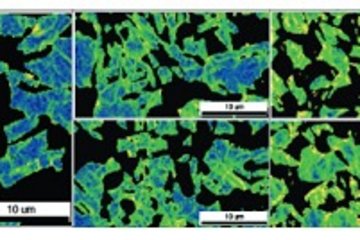All genres
681.
Journal Article
Rapid alloy prototyping: Compositional and thermo-mechanical high throughput bulk combinatorial design of structural materials based on the example of 30Mn–1.2C–xAl triplex steels. Acta Materialia 60, pp. 4950 - 4959 (2012)
682.
Journal Article
Nanoscale austenite reversion through partitioning, segregation and kinetic freezing: Example of a ductile 2 GPa Fe–Cr–C steel. Acta Materialia 60, pp. 2790 - 2804 (2012)
683.
Journal Article
Orientation informed nanoindentation of alpha-titanium: Indentation pileup in hexagonal metals deforming by prismatic slip. Focus Issue on Instrumented Indentation, pp. 356 - 367 (2012)
684.
Journal Article
Prediction of post-dynamic austenite-to-ferrite transformation and reverse transformation in a low-carbon steel by cellular automaton modeling. Acta Materialia 60, pp. 4768 - 4779 (2012)
685.
Journal Article
Deformation and fracture mechanisms in fine- and ultrafine-grained ferrite/martensite dual-phase steels and the effect of aging. Acta Materialia 59 (2), pp. 658 - 670 (2011)
686.
Journal Article
Methodological challenges in combining quantum-mechanical and continuum approaches for materials science applications. European Physics Journal Plus 126, pp. 101-1 - 101-22 (2011)
687.
Journal Article
Lightweight automotive construction (1): Steel research ensures Competitiveness of the Industry. Application-oriented basic research, prepares the way of the lightweight Automobile. Stahl und Eisen 131 (10), pp. 88 - 90 (2011)
688.
Journal Article
A phase-field model for incoherent martensitic transformations including plastic accommodation processes in the austenite. Journal of the Mechanics and Physics of Solids 59 (10), pp. 2082 - 2102 (2011)
689.
Journal Article
Atomic-scale mechanisms of deformation-induced cementite decomposition in pearlite. Acta Materialia 59 (10), pp. 3965 - 3977 (2011)
690.
Journal Article
Grain boundary electrochemistry of beta-type Nb–Ti alloy using a scanning droplet cell. Physica Status Solidi A-Applications and Materials Science 208 (6), pp. 1246 - 1251 (2011)
691.
Journal Article
Interdigitating biocalcite dendrites form a 3-D jigsaw structure in brachiopod shells. Acta Biomaterialia 7 (5), pp. 2237 - 2243 (2011)
692.
Journal Article
Phase Equilibria in the Fe–Nb System. Journal of Phase Equilibria and Diffusion 32 (2), pp. 97 - 104 (2011)
693.
Journal Article
A dislocation density-based crystal plasticity constitutive model for prismatic slip in α-titanium. Acta Materialia 59, 18, pp. 7003 - 7009 (2011)
694.
Journal Article
Lattice Boltzmann study of pattern formation in reaction-diffusion systems. Physical Review E 83 (016702), pp. 016702-1 - 016702-14 (2011)
695.
Journal Article
Comparative atom probe study of Cu(In,Ga)Se2 thin-film solar cells deposited on soda-lime glass and mild steel substrates. Journal of Applied Physics 110 (12), 124513 (7pp) (2011)
696.
Journal Article
Thermal stability of TiAlN/CrN multilayer coatings studied by atom probe tomography. Ultramicroscopy 111, pp. 518 - 523 (2011)
697.
Journal Article
Characterization of grain boundaries in Cu(In,Ga)Se2 films using atom probe tomography. Journal of Photovoltaics 1, pp. 207 - 212 (2011)
698.
Journal Article
Atomic-scale characterization of the CdS/CuInSe2 interface in thin-film solar cells. Applied Physics Letters 98, pp. 103504-1 - 103504-3 (2011)
699.
Journal Article
Atomic-scale distribution of impurities in CuInSe2-based thin-film solar cells. Ultramicroscopy 111 (6), pp. 552 - 556 (2011)
700.
Journal Article
Pulsed-laser atom probe studies of a precipitation hardened maraging TRIP steel. Ultramicroscopy 111, pp. 623 - 627 (2011)











